Ann Lethbridge's Blog, page 17
March 10, 2014
Regency News and Adverts
La Belle Assemblee 1813, March
Here are a couple of pieces you might find interesting
Married
At Warrington: Mr. William Leather, breadmaker, to Miss Nanny7 Holland, confectioner, after a tedious courtship of thirty-six years.
Do you think the marriage was less "tedious". Do you think combination of baker and confectioner was all about business?
Died
The Hon. Harriet Pryse, Lady of Pryse Pryse, Esq. of Gogerddan. This afflicting event was occasioned by the following accident:
As Mrs Pryse was preparing to go to bed, between two and three o'clock, on the morning fo New Year's day, her night-dress came in contacts with a rushlight that was burning in the room, and was instantly in a blaze.
While this last is not happy topic it contains some useful gems from speech at the time. I was interested in the use of a rush light give that this woman is clearly not of lower orders. But candles were expensive.
Advertisement
Rowland's Essence of Tyre;
Or Imperial Dye,
A Chemical peparation of wonderful metamorphosing powers,. for emmediately and effectually change the Hair when Red or Grey, to a beautiful Black, Brown, or Auburn. Price 7s 6d. per bottle.
Clear evidence that red hair is worse than grey? What do you think?
I hope you enjoyed this mornings offerings. Please comment so that I can continue this blog.
Until next time, if there is a next time.......
Here are a couple of pieces you might find interesting
Married
At Warrington: Mr. William Leather, breadmaker, to Miss Nanny7 Holland, confectioner, after a tedious courtship of thirty-six years.
Do you think the marriage was less "tedious". Do you think combination of baker and confectioner was all about business?
Died
The Hon. Harriet Pryse, Lady of Pryse Pryse, Esq. of Gogerddan. This afflicting event was occasioned by the following accident:
As Mrs Pryse was preparing to go to bed, between two and three o'clock, on the morning fo New Year's day, her night-dress came in contacts with a rushlight that was burning in the room, and was instantly in a blaze.
While this last is not happy topic it contains some useful gems from speech at the time. I was interested in the use of a rush light give that this woman is clearly not of lower orders. But candles were expensive.
Advertisement
Rowland's Essence of Tyre;
Or Imperial Dye,
A Chemical peparation of wonderful metamorphosing powers,. for emmediately and effectually change the Hair when Red or Grey, to a beautiful Black, Brown, or Auburn. Price 7s 6d. per bottle.
Clear evidence that red hair is worse than grey? What do you think?
I hope you enjoyed this mornings offerings. Please comment so that I can continue this blog.
Until next time, if there is a next time.......
Published on March 10, 2014 08:00
March 3, 2014
Montacute House I
Moving on from Devon, we find ourselves in Somerset.
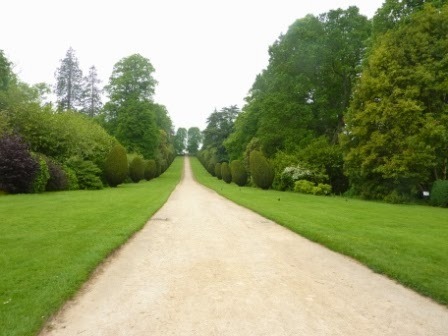 At Montacute House.
At Montacute House.
A house built in the late fifteen hundreds. by Sir Edward Phelips.
The warm stone came from nearby Ham Hill and has been described as "the most beautiful Elizabethan House in England".
It must be noted that little of the original furnishings remain from any of the eras in which we might be interested, but the building and the decoration is original and would have been so during the Regency.
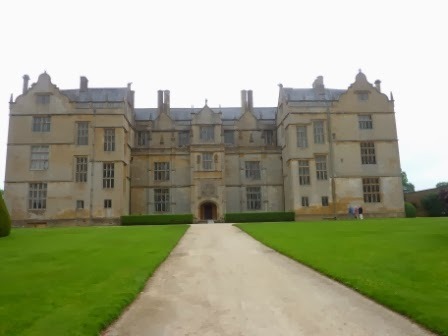
These external views show an extraordinary house.
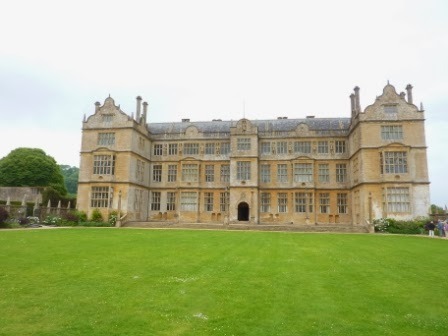
This is a view of the east front, the principal front of Montacute. and is designed in the typical "E" formation from this period. It also follows the height of Elizabethan fashion with its extensive areas of glittering glass. A hugely expensive proposition at this time.
Between each window on the top, third, story, and on the gable of the central bay are statues of the nine worthies - Joshua, David, Judas Maccabaeus, Hector, Alexander, Julius Caesar, King Arthur, Charlemagne and Godfrey of Bouillon.
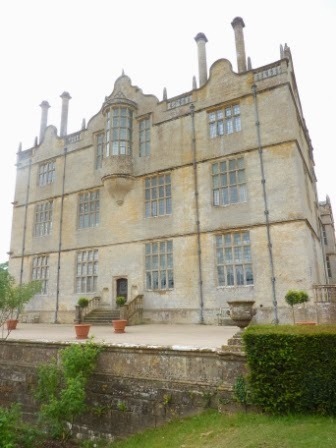
The house is topped of with Flemish-type gables, whose curves were a fashion imported in the late 1570s
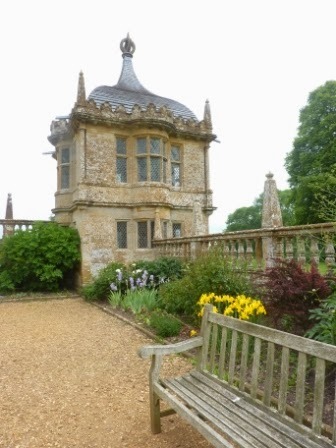
This is a pavillion, one of a pair each side of the forecourt at the east front were built and used as extra bedrooms.
There will be much more to come about this lovely house.
Until next time, Happy Rambles
 At Montacute House.
At Montacute House.A house built in the late fifteen hundreds. by Sir Edward Phelips.
The warm stone came from nearby Ham Hill and has been described as "the most beautiful Elizabethan House in England".
It must be noted that little of the original furnishings remain from any of the eras in which we might be interested, but the building and the decoration is original and would have been so during the Regency.

These external views show an extraordinary house.

This is a view of the east front, the principal front of Montacute. and is designed in the typical "E" formation from this period. It also follows the height of Elizabethan fashion with its extensive areas of glittering glass. A hugely expensive proposition at this time.
Between each window on the top, third, story, and on the gable of the central bay are statues of the nine worthies - Joshua, David, Judas Maccabaeus, Hector, Alexander, Julius Caesar, King Arthur, Charlemagne and Godfrey of Bouillon.

The house is topped of with Flemish-type gables, whose curves were a fashion imported in the late 1570s

This is a pavillion, one of a pair each side of the forecourt at the east front were built and used as extra bedrooms.
There will be much more to come about this lovely house.
Until next time, Happy Rambles
Published on March 03, 2014 13:23
February 24, 2014
Regency Fashion February 1814
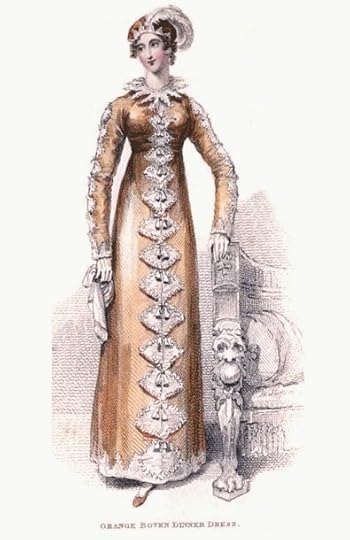 I am squeaking this one in before we hit the end of the month. You may have noticed the pattern. I am trying to give you dresses exactly 200 years old. I have another couple for this month so I am going to put them in later this week, so you have them all. Back to regular scheduling for March.
I am squeaking this one in before we hit the end of the month. You may have noticed the pattern. I am trying to give you dresses exactly 200 years old. I have another couple for this month so I am going to put them in later this week, so you have them all. Back to regular scheduling for March.While the title on the plate says "Dinner Dress" The description calls it a Carriage Pelisse. I assume the two are not incompatible, and it is a carriage dress one could wear to dinner. It is certainly gorgeous enough to go anywhere and the detail says that each of those little tassels is a tie. Heaven help the poor maid having to do that one up and clearly one wouldn't be removing it when one arrived for dinner. I love the elegant lines of this gown despite the fussiness of the trim.
Here is the description for your delectation and delight from La Bell Assemblee January 1814 issue, February Fashions.
Orange Boven Carriage Pelisse
A pelisse of the most delicate fawn colour Irish poplin, the skirt an easy fullness, the body tight to the shape, very short in the waist, and broad in the back.
The front, as our readers will see by the Plate, is very elegantly ornamented with white satin points put on at each side of the front; a beautiful white silk trimming edges each point, and white silk tassels of the lightest and most beautiful texture tie the pelisse all down the front.
The sleeve is ornamented in a similar manner on a smaller scale, but without the tassels: the bottom of the pelisse and the cuffs are also ornamented with white satin points, edged with silk trimming to correspond, and on each hip is a very novel and tasteful ornament, about the size of a large Spanish button; it is composed of floss silk, in the form of a shell.
A ruff of white satin cut in points, encircles the throat; it is supported, we believe, by ribband wire, or something of that sort, as it stands up round the throat, it is edged with a very fine narrow white lace. Head-dress a small Spanish cap of white satin, or fawn coloured velvet, tastefully ornamented with points edged with pearl, and a superb white ostrich feather, which falls to the left side. Fawn colour slippers and gloves. We have no hesitation in saying that this dress is the most elegant and novel that has appeared in the carriage costume for a considerable time.
Elegant and novel. I would have to agree. Until next time, Happy Rambles
Published on February 24, 2014 10:30
February 20, 2014
Fashion for February 1814
 This is an evening gown from
Ackerman's Repository
for February 1814, described as an Evening or Dancing
This is an evening gown from
Ackerman's Repository
for February 1814, described as an Evening or DancingThe length clearly allows for some jigging about in those very energetic country dances.
A white crape petticoat, worn over gossamer satin, ornamented at the feet with rows of puckered net, with a centre border of blue satin or velvet, in puffs.
A bodice of blue satin, with short full sleeves, and cuffs to correspond with the bottom of the dress. A full puckered border of net, or crape round the bosom.
Stomacher and belt of white satin, with pearl or diamond clasp.
Hair in disheveled curls, divided in front of the forehead, and ornamented with clusters of small variegated flowers; a large transparent Mechlin veil, thrown occasionally over the head, shading the bosom in front, and falling in graceful drapery beneath.
Ear-rings, necklace and bracelets of Oriental pearl, or white cornelian.
Slippers of white satin, with blue rosettes. White kid gloves; and fan of spangled crape and blue foil.
I like the idea of disheveled curls, don't you?
Until next time......
Published on February 20, 2014 06:00
February 17, 2014
Coming Soon
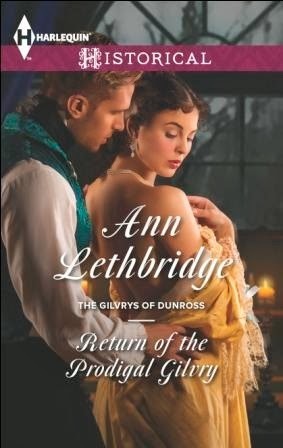 Here is your official Sneak Peek at my next cover and a little bit about the book.
Here is your official Sneak Peek at my next cover and a little bit about the book.Return of the Prodigal Gilvry
 will be out in May 2014 (April 15 in print) and is available for preorder. Click here to order from Amazon
will be out in May 2014 (April 15 in print) and is available for preorder. Click here to order from Amazon
BEHIND THE HIGHLANDER'S SCARS…
Reeling from betrayal, the once devastatingly handsome Andrew Gilvry has returned to Scottish shores to fulfill a promise made to a dying man. The widowed Rowena MacDonald has been entrusted to his care, and Drew must do all he can to protect her….
LIES A DARK PASSION!
But Drew's honor is about to be tested—because there's something in Rowena's dove-gray eyes that awakens a flame long extinguished. And on a perilous journey across the Highlands, with only this alluring woman for company, how long can he deny his desires?
This is the last of the Gilvrys of Dunross series (boy, I am going to miss the Scottish Highlands), The series was a spin off from Captured for the Captain's Pleasure and I am wondering if I should write Jaimie's story. He plays a much a very small part in several of these book. I suppose it will depend on popular demand.
Until next time .... well you know the drill.....
Published on February 17, 2014 06:00
February 10, 2014
Fashion for January 2014
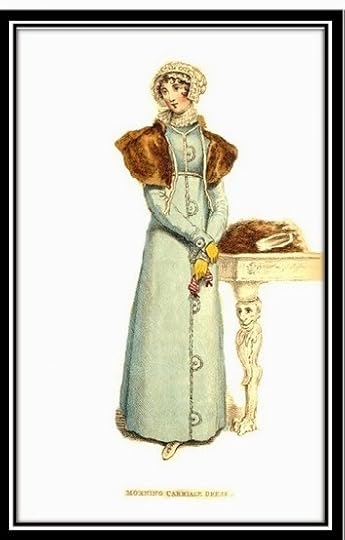 Today's offering is a Morning Carriage Dress from the December edition of La Belle Assemblee.
Today's offering is a Morning Carriage Dress from the December edition of La Belle Assemblee.It think this outfit would have been perfect for February too. The description is as follows.
Pelisse of the fashionable blue cloth, fastened down the front with small flaps, edged with silk trimming to correspond, in a manner that is perfectly novel, and that has a very singular effect; the cuff is also ornamented to correspond.
A very small cottage bonnet, composed of white satin, and of a most becoming and novel shape; the front, which is very small, displays a rich quilling of lace to correspond with the triple lace ruff.
The bonnet on the front is ornamented with a white satin ribband, which is so disposed as to have the appearance of a small wreath of white flowers; a white soft ribband ties it in a very full bow under the chin. Cloth half-boots to correspond with the dress. York tan gloves, and a seal-skin muff and tippet, finishes this dress.
Our modern day preferences would no doubt have us omitting the fur accoutrements, but since this is history, we include them.
Until Next time, Happy Rambles.
Published on February 10, 2014 05:50
February 3, 2014
Gentlemen's Clothing
On the issue of a gentleman's pockets.
There has been some discussion among those who undertake research on the Regency about the issue of where a gentleman might "put stuff on his person and quite often asserting that men did not have pockets in their pants (as we call them today).
I just read the following in La Belle Assemblee for January 1813, a description of an altercation regarding payment of his bill, between a Navy lieutenant and his host at a Tavern , namely the Horse and Groom Tavern, near the Asylum, London.
"...a waiter was directed to follow him and saw him, whilst in his room, put a dagger into the pocket of his pantaloons; some further altercation ensued and he drew the dagger, and pointed it at the plaintiff."
So clearly pockets large enough for a dagger of polished steel with a broad keen blade some six inches long were included in the construction of men's pantaloons. If I come across more detail, I shall be sure to add it to this snippet.
I should add the the officer offered the dagger to the judge as a gift, who took it and then told the lieutenant he must still find bail money to answer to the charge of an assault of an aggravated nature at Sessions, desipte the officer explaining that there was no altercation, he simply intended to show his friends the dagger.
There has been some discussion among those who undertake research on the Regency about the issue of where a gentleman might "put stuff on his person and quite often asserting that men did not have pockets in their pants (as we call them today).
I just read the following in La Belle Assemblee for January 1813, a description of an altercation regarding payment of his bill, between a Navy lieutenant and his host at a Tavern , namely the Horse and Groom Tavern, near the Asylum, London.
"...a waiter was directed to follow him and saw him, whilst in his room, put a dagger into the pocket of his pantaloons; some further altercation ensued and he drew the dagger, and pointed it at the plaintiff."
So clearly pockets large enough for a dagger of polished steel with a broad keen blade some six inches long were included in the construction of men's pantaloons. If I come across more detail, I shall be sure to add it to this snippet.
I should add the the officer offered the dagger to the judge as a gift, who took it and then told the lieutenant he must still find bail money to answer to the charge of an assault of an aggravated nature at Sessions, desipte the officer explaining that there was no altercation, he simply intended to show his friends the dagger.
Published on February 03, 2014 06:00
January 30, 2014
Regency Houses - Saltram Continued
I could not leave the library without a picture of this desk and several other items that are evocative of the Regency.
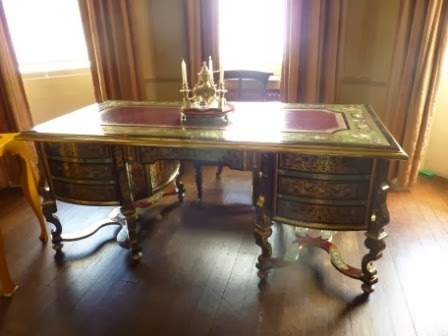 Family tradition says this desk was given to Sarah, Duchess of Marlborough who gave it to her granddaughter who gave it to Lady Catherine Parker. Made of beechwood inlaid with brass and shell it is thought to be by Boulle (1642 - 1732), but it was restored badly in the nineteenth century when the red leather insert was added.
Family tradition says this desk was given to Sarah, Duchess of Marlborough who gave it to her granddaughter who gave it to Lady Catherine Parker. Made of beechwood inlaid with brass and shell it is thought to be by Boulle (1642 - 1732), but it was restored badly in the nineteenth century when the red leather insert was added.
Even so, it really is a beautiful and extraordinary piece of furniture. On top is a silver gilt inkstand.
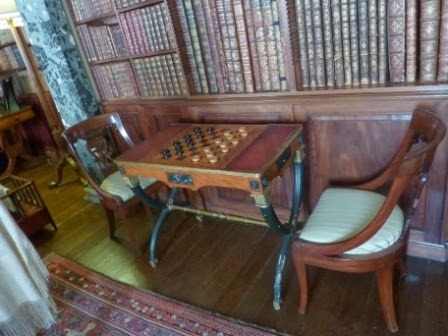 Naturally, since we are in the Regency, we have to feature other forms of entertainment. This is a rosewood games-table from the Regency era. Its cross over legs are painted to look like bronze and was made by the London firm J. McLane & Son (1770 to 1815) The middle section of the top is reversible and is fitted with a backgammon board. Here we see it set for draughts.
Naturally, since we are in the Regency, we have to feature other forms of entertainment. This is a rosewood games-table from the Regency era. Its cross over legs are painted to look like bronze and was made by the London firm J. McLane & Son (1770 to 1815) The middle section of the top is reversible and is fitted with a backgammon board. Here we see it set for draughts.
I would love a table like this.
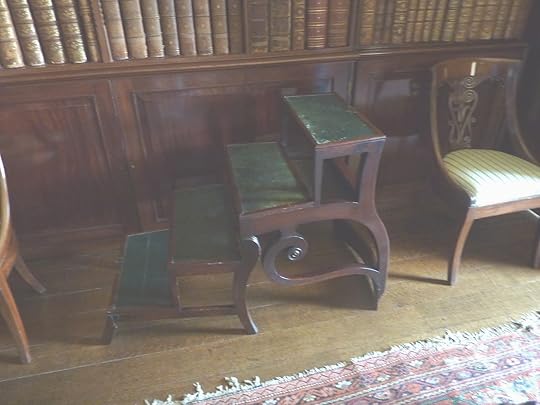 Another must have are library steps.
Another must have are library steps.
I lightened the picture because this corner was dark so the colour if off a bit.
These steps fold up to form a sabre-leg arm chair and is considered to be the Patent Metamorphic Library Chair by Morgan and Sanders pictured by Ackerman in 1811.
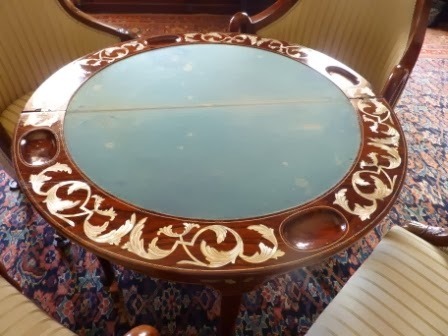
I have no information of this gaming table, but just loved it enough to include it, because of the scoops for money or chips. And the chairs.
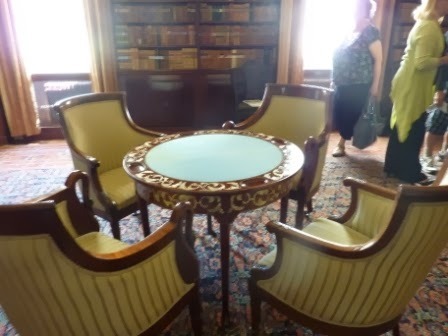 And so concludes our truncated tour of Saltram. There was much more to see and many more photos that I took, but I would encourage you to see it for yourself if you ever have the chance.
And so concludes our truncated tour of Saltram. There was much more to see and many more photos that I took, but I would encourage you to see it for yourself if you ever have the chance.
Until next time, Happy Rambles
 Family tradition says this desk was given to Sarah, Duchess of Marlborough who gave it to her granddaughter who gave it to Lady Catherine Parker. Made of beechwood inlaid with brass and shell it is thought to be by Boulle (1642 - 1732), but it was restored badly in the nineteenth century when the red leather insert was added.
Family tradition says this desk was given to Sarah, Duchess of Marlborough who gave it to her granddaughter who gave it to Lady Catherine Parker. Made of beechwood inlaid with brass and shell it is thought to be by Boulle (1642 - 1732), but it was restored badly in the nineteenth century when the red leather insert was added.Even so, it really is a beautiful and extraordinary piece of furniture. On top is a silver gilt inkstand.
 Naturally, since we are in the Regency, we have to feature other forms of entertainment. This is a rosewood games-table from the Regency era. Its cross over legs are painted to look like bronze and was made by the London firm J. McLane & Son (1770 to 1815) The middle section of the top is reversible and is fitted with a backgammon board. Here we see it set for draughts.
Naturally, since we are in the Regency, we have to feature other forms of entertainment. This is a rosewood games-table from the Regency era. Its cross over legs are painted to look like bronze and was made by the London firm J. McLane & Son (1770 to 1815) The middle section of the top is reversible and is fitted with a backgammon board. Here we see it set for draughts.I would love a table like this.
 Another must have are library steps.
Another must have are library steps.I lightened the picture because this corner was dark so the colour if off a bit.
These steps fold up to form a sabre-leg arm chair and is considered to be the Patent Metamorphic Library Chair by Morgan and Sanders pictured by Ackerman in 1811.

I have no information of this gaming table, but just loved it enough to include it, because of the scoops for money or chips. And the chairs.
 And so concludes our truncated tour of Saltram. There was much more to see and many more photos that I took, but I would encourage you to see it for yourself if you ever have the chance.
And so concludes our truncated tour of Saltram. There was much more to see and many more photos that I took, but I would encourage you to see it for yourself if you ever have the chance.Until next time, Happy Rambles
Published on January 30, 2014 06:00
January 27, 2014
Regency Fashion
January 2014
This is our second fashion plate for the month from Ackerman's Repository.
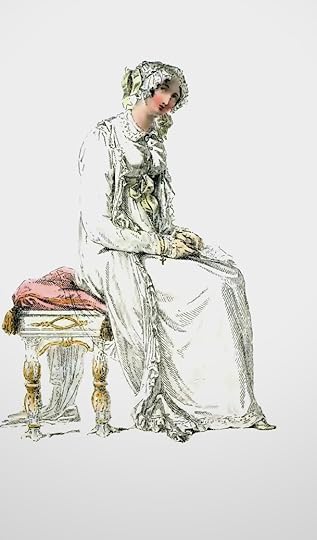 Morning Dress
Morning Dress
A round robe of plain jaconot muslin, with spencer bodice, and rounded falling collar, edged with lace or needle-work; the same ornamenting the bottom of the dress.
A loose robe pelisse of Indian muslin, thrown quite open in front, trimmed entirely round with a full gathered border of muslin or lace; the back confined at the bottom with a lemon-coloured ribband, brought round the waist, and tied in bows and ends in front.
The Flushing mop cap, composed entirely of lace, ornamented with lemon-coloured ribband, which also confines it under the chin. A small rosary and cross of amber, twisted round the wrist, and a broach of the same confining the dress at the throat. Slippers and gloves of lemon-coloured kid.
Such a pretty Dress don't you think, and I like the stool and cushion she is perched on. It looks like summer more than winter to me. And a Flushing mob cap. Flushing is the English name for a harbour in the Netherlands, called Vlissingen. In case you wanted to know. Why there is a mob cap named after it, I do not profess to know. But it is very sweet.
That's it until next time, Happy Rambles.
This is our second fashion plate for the month from Ackerman's Repository.
 Morning Dress
Morning Dress A round robe of plain jaconot muslin, with spencer bodice, and rounded falling collar, edged with lace or needle-work; the same ornamenting the bottom of the dress.
A loose robe pelisse of Indian muslin, thrown quite open in front, trimmed entirely round with a full gathered border of muslin or lace; the back confined at the bottom with a lemon-coloured ribband, brought round the waist, and tied in bows and ends in front.
The Flushing mop cap, composed entirely of lace, ornamented with lemon-coloured ribband, which also confines it under the chin. A small rosary and cross of amber, twisted round the wrist, and a broach of the same confining the dress at the throat. Slippers and gloves of lemon-coloured kid.
Such a pretty Dress don't you think, and I like the stool and cushion she is perched on. It looks like summer more than winter to me. And a Flushing mob cap. Flushing is the English name for a harbour in the Netherlands, called Vlissingen. In case you wanted to know. Why there is a mob cap named after it, I do not profess to know. But it is very sweet.
That's it until next time, Happy Rambles.
Published on January 27, 2014 06:00
January 12, 2014
Regency Fashion - January 2014
We are now well into the Regency of George Prince of Wales period and of course in the depths of the English winter. Nothing like the kind of winter we have the northern parts of North America, still warm clothing is a wise thing.
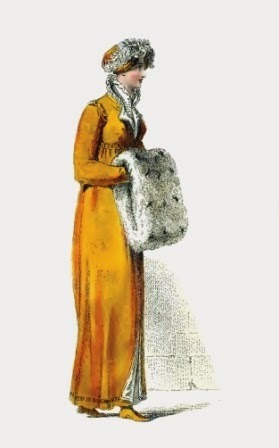
This Promenade costume from an Ackerman plate looks toasty.
A Plain cambric robe, with long gathered sleeve and high arched collar, trimmed with net lace or muslin. A Spanish lapelled coat of fine orange Merino cloth; full epaulette ornaments on the shoulders: the whole lined throughout with white sarsnet, and trimmed with a raised border of white velvet or swansdown.
A small, provincial bonnet of the same material as the coat, ornamented with full curled ostrich feather. White spotted ermine or Chinchilli muff. Gloves grey or light blue kid. Half-boots of orange-coloured jean or velvet.
Until next time, Happy Rambles.

This Promenade costume from an Ackerman plate looks toasty.
A Plain cambric robe, with long gathered sleeve and high arched collar, trimmed with net lace or muslin. A Spanish lapelled coat of fine orange Merino cloth; full epaulette ornaments on the shoulders: the whole lined throughout with white sarsnet, and trimmed with a raised border of white velvet or swansdown.
A small, provincial bonnet of the same material as the coat, ornamented with full curled ostrich feather. White spotted ermine or Chinchilli muff. Gloves grey or light blue kid. Half-boots of orange-coloured jean or velvet.
Until next time, Happy Rambles.
Published on January 12, 2014 20:16



